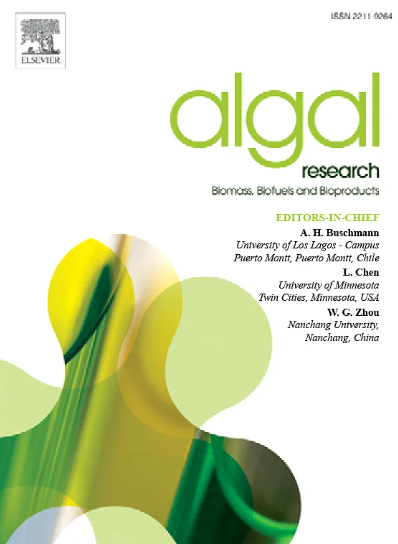缺氮缺磷佐银绿藻处理4类水产养殖废水的氮磷研究
IF 4.6
2区 生物学
Q1 BIOTECHNOLOGY & APPLIED MICROBIOLOGY
Algal Research-Biomass Biofuels and Bioproducts
Pub Date : 2025-06-02
DOI:10.1016/j.algal.2025.104127
引用次数: 0
摘要
随着养殖业集约化程度的逐步提高,产生了大量氮(N)磷(P)超标的养殖废水(AW)。本研究评估了缺氮、缺磷的佐ingiensis Chromochloris zofingiensis对中国软壳龟(Pelodiscus sinensis)、大口黑鲈(Micropterus salmoides)、凡纳滨对虾(Litopenaeus vannamei)和杂交鲟(Acipenser baerii♂× Acipenser schrenckii♀)4种AW的治疗可行性。总氮浓度为14.63 ~ 63.54 mg L−1,总磷浓度为0.36 ~ 5.78 mg L−1。4种AW对总氮和总磷的去除率分别为79.08% ~ 97.54%和38.80% ~ 83.02%。此外,zofingiensis在salmoides AW中的蛋白质含量在第6天最高,达到0.46 g g−1。其中脂肪酸和虾青素含量在杂交鲟AW中最高,分别达到0.59 g g−1和0.95 mg g−1。此外,四种类型的AW处理后,zofingiensis显示出促进水产动物健康的氨基酸和脂肪酸组成。因此,提出了一种水处理的回收方案。综上所述,本研究证明了利用缺氮、缺磷的zofingiensis将AW中的N、P转化为营养物质的可行性,可作为水产饲料添加剂。本文章由计算机程序翻译,如有差异,请以英文原文为准。
Treatment of nitrogen and phosphorus for four types of aquaculture wastewater by using nitrogen- and phosphorus-starved Chromochloris zofingiensis
With the gradual increase in the degree of intensification of aquaculture industry, large amounts of aquaculture wastewater (AW) with excess nitrogen (N) and phosphorus (P) are generated. In this study, the treatment feasibility of four types of AW, including the Chinese soft-shelled turtle (Pelodiscus sinensis) AW, the Largemouth bass (Micropterus salmoides) AW, the Pacific white shrimp (Litopenaeus vannamei) AW, and the Hybrid sturgeon (Acipenser baerii ♂ × Acipenser schrenckii ♀) AW by N- and P-starved Chromochloris zofingiensis was assessed. The total N concentration ranged from 14.63 mg L−1 to 63.54 mg L−1, while the total P concentration ranged from 0.36 mg L−1 to 5.78 mg L−1. The removal efficiencies of total N and total P from four types of AW ranged from 79.08 % to 97.54 % and 38.80 % to 83.02 %, respectively. In addition, C. zofingiensis achieved the highest protein content in M. salmoides AW on day 6, reaching 0.46 g g−1. Where it achieved the highest fatty acids and astaxanthin content in Hybrid sturgeon AW, reaching 0.59 g g−1 and 0.95 mg g−1, respectively. In addition, C. zofingiensis exhibited a health-promoting amino acid and fatty acid composition for aquaculture animals after treatment with the four types of AW. Therefore, a recycling scheme AW treatment was proposed. Overall, this study demonstrated the feasibility of using N- and P-starved C. zofingiensis to convert N and P from AW into nutrients, which can be applied as aquafeed additives.
求助全文
通过发布文献求助,成功后即可免费获取论文全文。
去求助
来源期刊

Algal Research-Biomass Biofuels and Bioproducts
BIOTECHNOLOGY & APPLIED MICROBIOLOGY-
CiteScore
9.40
自引率
7.80%
发文量
332
期刊介绍:
Algal Research is an international phycology journal covering all areas of emerging technologies in algae biology, biomass production, cultivation, harvesting, extraction, bioproducts, biorefinery, engineering, and econometrics. Algae is defined to include cyanobacteria, microalgae, and protists and symbionts of interest in biotechnology. The journal publishes original research and reviews for the following scope: algal biology, including but not exclusive to: phylogeny, biodiversity, molecular traits, metabolic regulation, and genetic engineering, algal cultivation, e.g. phototrophic systems, heterotrophic systems, and mixotrophic systems, algal harvesting and extraction systems, biotechnology to convert algal biomass and components into biofuels and bioproducts, e.g., nutraceuticals, pharmaceuticals, animal feed, plastics, etc. algal products and their economic assessment
 求助内容:
求助内容: 应助结果提醒方式:
应助结果提醒方式:


